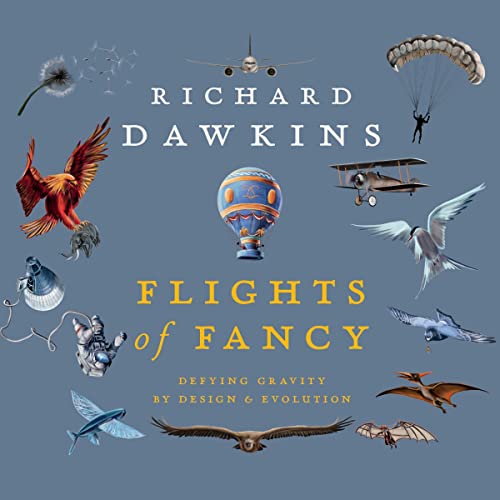Richard Dawkins is a British evolutionary biologist and author. He is an emeritus fellow of New College, Oxford. An atheist, he is well known for his criticism of creationism and intelligent design. Dawkins first came to prominence with his 1976 book The Selfish Gene, which popularized the gene-centered view of evolution. He has written a number of other books as well. His latest, which I have just finished reading, is Flights of Fancy, Defying Gravity by Design and Evolution.

The book, about flight, both animal and human, was a quick read for me, partly because I am familiar with most of the content (as an ornithologist and pilot), the pages were easy on the eyes and there were a number of very attractive illustrations, many full page, often double page. Dawkins is a big name in biology, especially evolution, and I’m betting he wrote much of this book off the top of his head and without having to dig through too many resources. There is some awkward wording and repetition that make it seem that the writing was quick and not up to his usual excellent narrative. Although I didn’t find the book intellectually fulfilling as it was written for a less academic audience than is usual for Dawkin’s books, it is nonetheless interesting because there were lots of fascinating tidbits.
Unfortunately, there are a few errors and omissions in the text. He repeats the idea, now pretty much rejected, that feathers evolved from reptilian scales by evolutionary modification. It is now thought that feathers actually evolved as new structures distinct from scales. Dawkins also says that hollow bones are a bit weaker than solid ones. This is not necessarily a mistake but an oversimplification because there is a lot of variability in bone density, whether the bone is hollow or not, but physics tells us that any tubular structure is stronger than a solid tube of the same material.
When he talks about the flight of helicopters he says that they have a tail rotor to prevent rotation but doesn’t explain why a helicopter would rotate without it (the torque generated by the main blades would spin the helicopter in the opposite direction.) Dawkins spends nearly an entire chapter on pollination mechanisms and vectors like insects and hummingbirds, but nowhere does he explain how the wings of insects work which seems to fit better with the point of the book than spending time discussing the long proboscis of some insects.
But I quibble. This book is a nice and easy read, and I might even say delightful, overview of the world of flight. It often brings up interesting and yet unsolved mysteries. Did Quetzalcoatlus, a pterosaur that lived about 68 million years ago, fly? It stood as high as a giraffe and was built for flight, but it may have been too heavy to do anything but glide. How do we know? Why was Tinkerbell so small? And can angels really fly with the wings we imagine they have? Why are bats the only mammals that achieved true flight? And where do humans go from here in their quest to fly into space?
Thank you for the review Dr. L. On your recommendation I will give “Flights of Fancy” a look.
I have been reading J. A. Baker, which has taken me to a number of other UK “nature writers”, e.g. Robert Macfarlane and Roger Deakin. I am putting together a proposal for MacFarlane and his publishers as well as Baker’s publisher and literary agent to release “The Peregrine” (Baker) and two of Macfarlane’s books (“Wildplaces”, and “Landmarks”) using what I am calling “dynamic illustration”. If you are interested, I would value any comments you might have concerning such a project.
I found it teeth-gratingly awful.
So many errors and misconceptions and so many interesting things left out.
His explanation if how wings develop lift is nonsense – and that is just the start. And he apparently doesn’t know that dinosaurs used feathers for display – which might explain how large, strong feathers evolved on the arms.
There is no discussion of the significance of the aspect ratio of wings or why small birds never glide or how insects live in an utterly different aerodynamic regime where turbulence doesn’t happen and streamlining is not important.
I wonder if he ran the manuscript past anyone who knows anything about aerodynamics.
(FH Former Airbus Design Engineer)